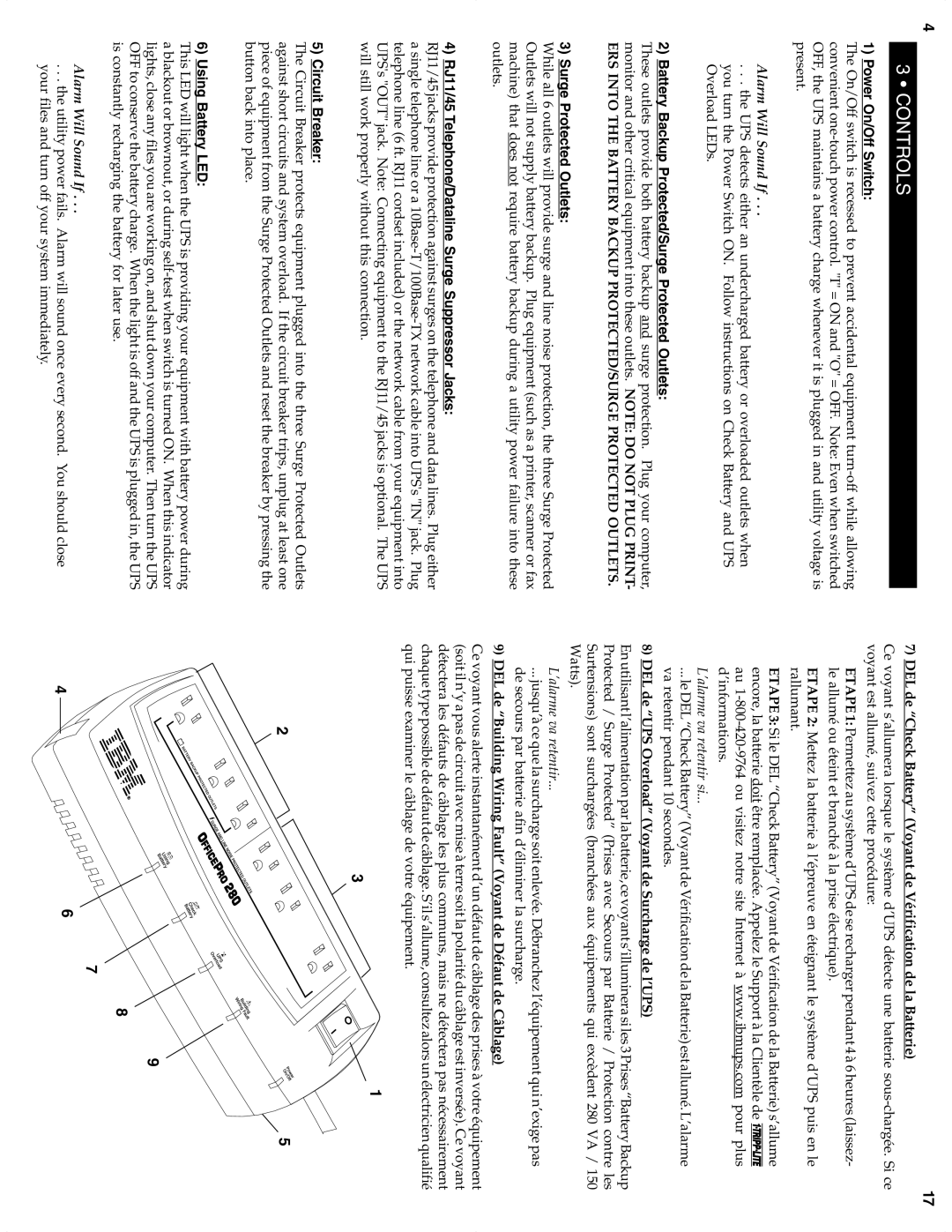
4
3 • CONTROLS
1) Power On/Off Switch:
The On/Off switch is recessed to prevent accidental equipment
Alarm Will Sound If . . .
. . . the UPS detects either an undercharged battery or overloaded outlets when you turn the Power Switch ON. Follow instructions on Check Battery and UPS Overload LEDs.
2) Battery Backup Protected/Surge Protected Outlets:
These outlets provide both battery backup and surge protection. Plug your computer, monitor and other critical equipment into these outlets. NOTE: DO NOT PLUG PRINT-
ERS INTO THE BATTERY BACKUP PROTECTED/SURGE PROTECTED OUTLETS.
3) Surge Protected Outlets:
While all 6 outlets will provide surge and line noise protection, the three Surge Protected Outlets will not supply battery backup. Plug equipment (such as a printer, scanner or fax machine) that does not require battery backup during a utility power failure into these outlets.
4) RJ11/45 Telephone/Dataline Surge Suppressor Jacks:
RJ11/45 jacks provide protection against surges on the telephone and data lines. Plug either a single telephone line or a
5) Circuit Breaker:
The Circuit Breaker protects equipment plugged into the three Surge Protected Outlets against short circuits and system overload. If the circuit breaker trips, unplug at least one piece of equipment from the Surge Protected Outlets and reset the breaker by pressing the button back into place.
6) Using Battery LED:
This LED will light when the UPS is providing your equipment with battery power during a blackout or brownout, or during
Alarm Will Sound If . . .
. . . the utility power fails. Alarm will sound once every second. You should close your files and turn off your system immediately.
17
7) DEL de “Check Battery” (Voyant de Vérification de la Batterie)
Ce voyant s’allumera lorsque le système d’UPS détecte une batterie
ETAPE 1: Permettez au système d’UPS de se recharger pendant 4 à 6 heures (laissez- le allumé ou éteint et branché à la prise électrique).
ETAPE 2: Mettez la batterie à l’épreuve en éteignant le système d’UPS puis en le rallumant.
ETAPE 3: Si le DEL “Check Battery” (Voyant de Vérification de la Batterie) s’allume encore, la batterie doit être remplacée. Appelez le Support à la Clientèle de ![]() au
au
L’alarme va retentir si...
... le DEL “Check Battery” (Voyant de Vérification de la Batterie) est allumé. L’alarme va retentir pendant 10 secondes.
8) DEL de “UPS Overload” (Voyant de Surcharge de l’UPS)
Enutilisantl’alimentationparlabatterie,cevoyants’illuminerasiles3Prises“BatteryBackup Protected / Surge Protected” (Prises avec Secours par Batterie / Protection contre les Surtensions) sont surchargées (branchées aux équipements qui excèdent 280 VA / 150 Watts).
L’alarme va retentir...
... jusqu’à ce que la surcharge soit enlevée. Débranchez l’équipement qui n’exige pas de secours par batterie afin d’éliminer la surcharge.
9) DEL de “Building Wiring Fault” (Voyant de Défaut de Câblage)
Ce voyant vous alerte instantanément d’un défaut de câblage des prises à votre équipement (soit il n’y a pas de circuit avec mise à terre soit la polarité du câblage est inversée). Ce voyant détectera les défauts de câblage les plus communs, mais ne détectera pas nécessairement chaque type possible de défaut de câblage. S’il s’allume, consultez alors un électricien qualifié qui puisse examiner le câblage de votre équipement.
1
3
2 | 5 |
9
8
7
4 | 6 |
|
